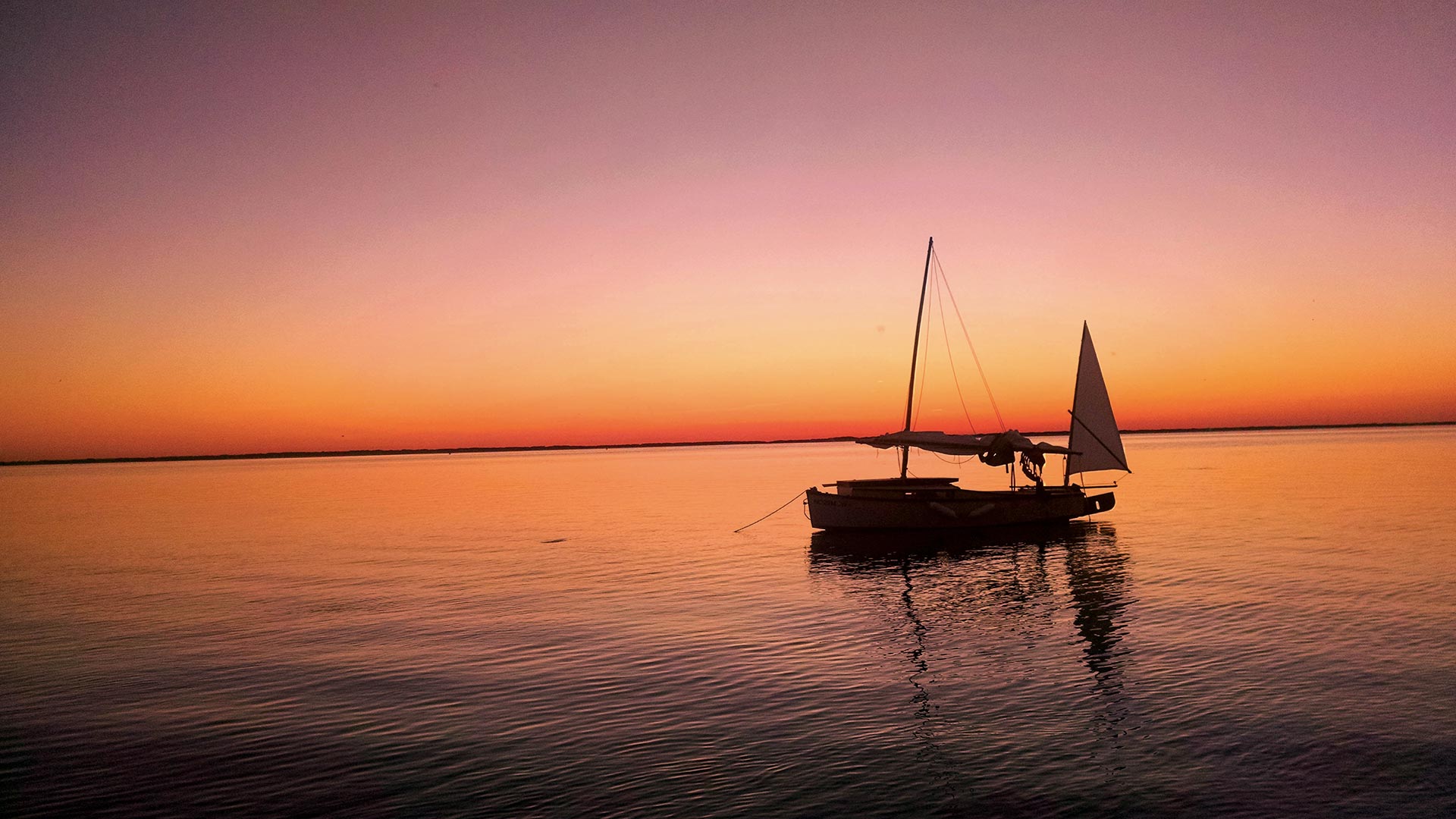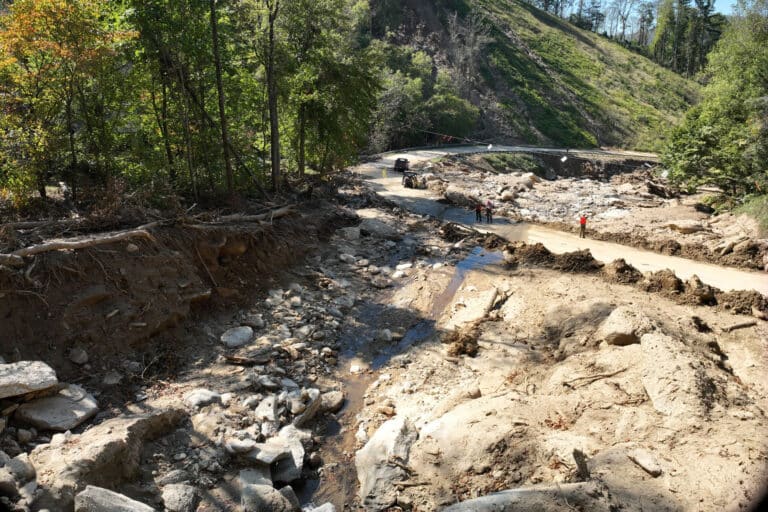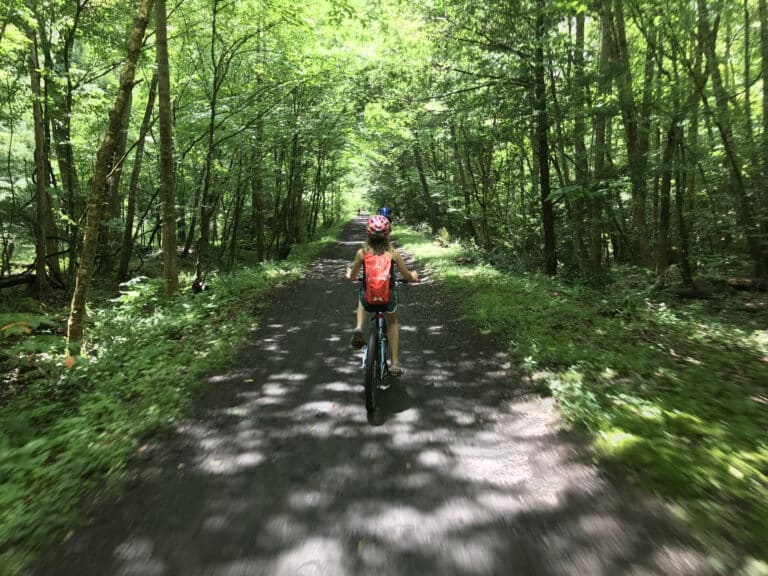Ever since the beginning of time, humans have been drawn to the water’s edge. This month we head to the coast to meet sailors and surfers who call the Atlantic home.
THE SAILOR / Sean Moffitt / Chapel Hill, N.C.
Can you pinpoint your earliest experience at the beach? Sean Moffitt can, and though later in life he would go on to develop an all-consuming passion for sailing the open seas, that first memory wasn’t exactly awe-inspiring.
“I got a shrimp caught in my shirt. I was terrified. I cried and cried and cried. I was just a kid. In my memory it was huge.”
Whatever that run-in with the shrimp did in the short term, it hardly daunted Moffitt. He became curious, just like his father. Mr. Moffitt is what you might call a tinkerer—he’s done just about everything from raising bonsai plants to engineering robotics—but one summer, about the time Sean was 12, he started building sailboats.
“Our boats are not necessarily pretty,” says Moffitt. “They are meant to be used, not sitting in the harbor. The physical structure is all built out of plywood, the sails we make are made from poly tarps, all of which you can get at Lowe’s.”
At age 13, Moffitt and his cousin built their first sailboat. For its maiden voyage, they sailed it on the Gulf of Mexico. Then just a teenager whose world was mostly confined to the booming city of Atlanta, Moffitt remembers the thrill of open water and the simultaneous pressure of handling a vessel of his own creation.
“It was a little nerve-wracking to be sailing on your own as a 13-year-old in the Gulf of Mexico,” he says. “It was almost like a forced meditation. You had to be in tune with everything. It was a very calming and humbling experience for me.”
Initially, the trips were short, just a few hours or so. But with every summer, the sailing became longer until eventually, Moffitt and his family were overnighting off of their sailboats, sailing by day and camping on the beaches of the Outer Banks by night.
Inspired by Florida’s WaterTribe Everglades Challenge, a 300-mile unsupported sailing race, Moffitt’s brother Paul started the OBX 130 sailing raid in 2008. Right from the beginning, the Moffitts wanted to make the event less of a race and more of an adventure. The 130-mile, self-supported group sail takes place every other year off the coast of the Outer Banks. That first year, at age 21, Moffitt solo captained a new boat he had built in college, this one 12 feet in length.
“Compared to the weather that year, that was a tiny boat,” Moffitt remembers. “I remember waves crashing over the front of the boat. The weather was crazy. I learned how to rest my sail in the middle of the storm. It was one of those pushing-to-my-limits kind of experience, but I did it. I sailed 130 miles in this tiny boat. It was the most proud I’ve ever been.”
To date, Moffitt himself has built three boats, his father four, and his brother Paul three. The boats range anywhere from eight feet long to more than double that in size. They’re monohulls, made for navigating the shallow waters and sandbars of the Outer Banks.
A couple of years after that first solo captain success, Moffitt set out from the North Carolina shore to retrace the OBX 130 route, this time completely alone and without an armada of other sailors to keep him company at camp. His goal was to spend the entire three-month summer aboard his sailboat, which he retrofitted so he could sleep onboard, but after two weeks, he was done.
“That first night alone was the beginning of a storm with insane 25 knot winds. I couldn’t even leave the shore for two or three days. I was just camped underneath the lighthouse at Cape Lookout, waiting. It was a pretty rough start. It was really hard for me. All of my peers seemed to have lives and apartments and significant others and jobs and I didn’t. I was on this boat. I had every beach to myself and went wherever I wanted. I had an amazing experience, but a younger me had a much harder time with it.”
Recently, Moffitt has taken his love of the natural world inland as a Field Coordinator for the North Carolina Youth Conservation Corps. He’s currently in graduate school studying to become a licensed social worker and therapist, so that he can integrate wilderness therapy into his conservation work. The sea has never left him, nor those memories of sailing free, and he says his hope is to bring his conservation and youth work to the waters that have so defined his life.
“She’s the mother ocean. Every time I go I feel like I’m returning to the womb. I’ve probably spent as much time in the mountains as I have in the ocean, but the ocean is much more special to me.”
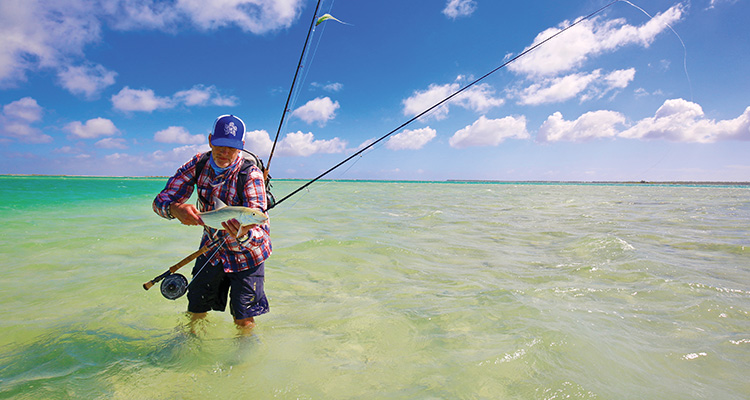
THE ANGLER / Art Webb / Virginia Beach, Va.
It’s hard to imagine that someone who grew up fishing bass in the land-locked state of Missouri could ever learn to love fishing the Atlantic waters, but that’s exactly what happened to Art Webb.
“To this day I still don’t consider myself a ‘beach person,’” Webb says, chuckling. “I’m a water person, no doubt, but to be honest, beaches attract way too much humanity for me.”
He would know. He’s lived at the edge of Virginia Beach’s busy boardwalk for two decades. And while his first experiences fishing saltwater were in the shallow coastal flats, it wasn’t long before he was venturing off-shore with a fly rod in hand, searching for billfish.
“The first fish I hooked and brought boatside probably eclipsed the sum of all other fish I had caught up to that point,” he says. “I can’t even put into words how berserk they go and what it feels like to have them on the end of the fly rod. It’s like nothing I’ve ever done, save for tarpin.”
Early on, people weren’t sure what to make of the charming fellow on board who was attempting to catch billfish on fly. It just wasn’t something that was done, especially in those parts. Webb hardly seemed to mind the skepticism, and after a number of successful outings, he convinced fellow fly fishermen Brian and Colby Trow of Mossy Creek Fly Fishing to come see for themselves.
The result of their exploits can be experienced firsthand in the film Tidewater, produced by TwoFisted Heart Productions and released in 2016. With unpredictable weather, fickle fish, and a time-crunched video shoot, the adventure was for Webb, an advertising tycoon by trade, pure bliss. He says of all the blue marlin and billfish they did end up catching, none stands out so clearly in his mind as the one that got away, or simply never was.
It was a blue marlin, some 12 feet long and 700 pounds in size. The fish was close, within casting range for Webb, who was at the rod. Pulsing with adrenaline, Webb cast his line out into the water, not sure if he was fully ready for the fight that lay ahead.
“It was a pink fly, I will remember that as long as I live. That fish hovered underneath that pink fly deciding whether or not to eat it and I didn’t know whether I wanted more than anything for that fish to eat it or not, because 700 pounds of fish on the end of a fly rod would have either been the battle of all time that would have lasted for days, or I would have lost the fly line and 200 yards of backing. There was going to be nothing in between.”
The marlin spared Webb that day, but even now, years after the filming of Tidewater, he still marvels at the energy he felt from that fish gliding beneath the surface of the water. It’s that and the many other experiences he’s had around the world that inspired him to create his very own fly fishing travel agency called World Wide Webb Adventures.
When he’s not working on his new business endeavor, he’s usually fishing with his two kids, Olivia and Harrison, or building awareness for his passion project Able Women, a women’s fly fishing team. He says being the father of a daughter has impressed upon him the importance of reminding girls that identity and sense of self-worth go well beyond physical beauty. He believes sports like fly fishing have a powerful ability to build confidence and empower women to see themselves as capable and competent, on and off the water.
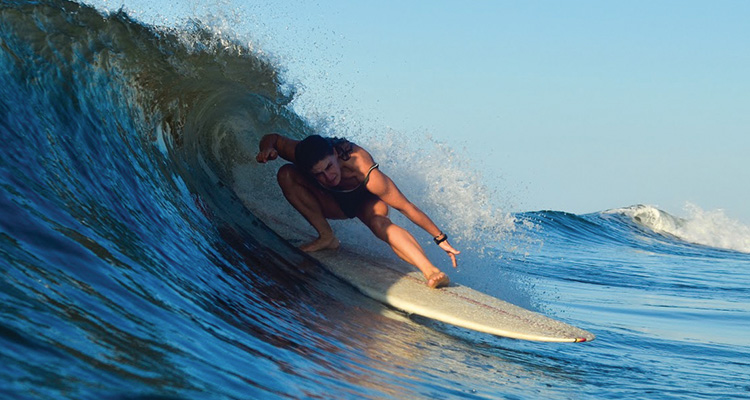
THE ARTIST / Kate Barattini / Folly Beach, S.C.
Were you to ask 28-year-old Kate Barattini how she ended up on Folly Beach, she’d tell you it was because she was a clown in high school, that she was rejected from her dream school Clemson University, where she wanted to study parks and recreation, and admitted to the College of Charleston instead. In reality, the answer is much simpler: the ocean came to her.
“I grew up living close to the mountains and I was really into whitewater kayaking,” she says. “That’s all I did throughout my junior and senior years of high school. My freshman year of college I worked on the Pigeon River. I just loved the mountains and the rivers and everything that went with that.”
In college, she joined the crew team in hopes that she would find some other river-loving souls. To her initial dismay, she did not. She tried taking her kayak to the ocean to get her paddling fix, but it wasn’t the same.
“I didn’t understand the waves. It was hard and I was young and stubborn. I decided I would start surfing and I told myself by the end of college, I was going to be good at surfing.”
So she did just that. She moved to Folly Beach, bought the first board she could find, and forced herself to begin a new relationship with water. It wasn’t easy. That first day on her new board, she could hardly make it past the break.
“It was a head high day, nasty conditions, and I couldn’t even get out there. After awhile I just got out of the water and sat on my board thinking, What am I doing with my life? I had bought a board, a wetsuit, because of course it was February, but I told myself I was going to do it.”
Barattini finally took a lesson from Jenny Brown, an All-Star Team Surfer in the Eastern Surfing Association and an instructor with Shaka Surf School. Now, 10 years later, Barattini is a seasoned surfer. She has lived and surfed in Nicaragua, competed in the classic longboarding event Mexi Log Fest in Saladita, Mexico, and won her hometown Folly Beach Wahine Classic three years in a row.
For Barattini, surfing is first and foremost an expression of self. She’s an artist and filmmaker, too, and she says her time in the water directly influences her work. Her most recent series, Animal Shred, depicts paintings of real-life surfers with animal characteristics: the head of a lion, the wing of a butterfly. Just like surfing, Barattini says that creating art provides her with constant lessons in patience and humility.
“You have times when you’re really really good at it and then you have times where, for whatever reason, things are just not clicking, and because of that, it’s always fulfilling. You’re always trying to perfect yourself, but at the same time, you have to be happy with where you are.”
She is currently working on a continuation of the Animal Shred series, which she will release at a show later this year, as well as another Folly-themed surf film. She works as a bartender two nights a week to supplement her income, because, as she says, “if you want to be a surfer on the East Coast, south of the Outer Banks and north of Florida, you kinda need a job that allows you to have a lot of free time to surf as much as you can. Otherwise you’ll just be grumpy.”
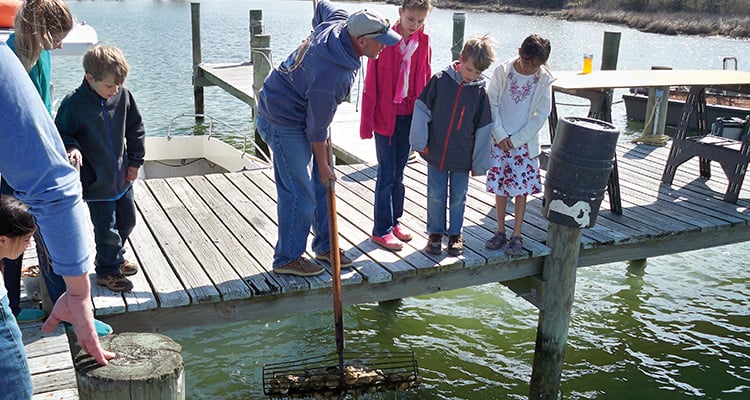
THE WATERMAN / Phil Langley / Dameron, Md.
Captain Phil Langley was born and raised on the Chesapeake Bay. He’s lived in St. Mary’s County his whole life. As a child, he worked the tobacco fields and oyster beds of southern Maryland. He comes from a long line of hardworking men—his paternal grandfather was a farmer and his maternal grandfather a waterman who ran skipjacks up and down the Bay.
“Even before I had a good memory, I can remember going crabbing and fishing with my dad,” Langley says. “We grew up with a pretty modest lifestyle, so that was the recreation around here.”
Langley’s deep-set eyes are clear and blue, like the waters that surround him. Were it not for the slightest of creases at the edge of his temples, you might never know that the 57-year-old has spent the better part of three decades working the water crabbing, oystering, and fishing.
It’s a hard line of work—Langley will be the first to admit that. During the 1990s, when the oyster population was at its lowest and the state of Maryland had issued a five-year moratorium on striped bass fishing, Langley was forced to pick up work with a heating and air conditioning company to support his family. But he never stopped getting out on the water, and he never will.
“I was born with saltwater in my veins. There’s a lot of other things I could have done with my life, but you can’t drag me off the water with a team of mules.”
Over all of these years, for better and for worse, Langley has witnessed his beloved Bay ebb and flow. Fortunately, the oysters seem to be making a comeback. Langley has a small oyster bed on his property, something he would have never dreamed of investing in 20 years ago. He’s hoping to harvest between 600 and 800 bushels this year. Long ago, he realized that it wasn’t realistic to sustain his family entirely on crabbing and oystering, so he started offering waterman heritage cruises, charter fishing, and ecotours through his company Fish the Bay Charters.
In a way, his passion for the Chesapeake has come full circle. As a kid he crabbed and oystered for fun, as an adult he harvested crabs and oysters for a living, and now he gets to take visitors on their own crabbing and fishing adventures while teaching them about the resource and the threats it faces.
“My number one passion is nature, but I would say it’s the people that keep me enthusiastic in what I do,” says Langley. “On a fishing boat, I’ll take out people that have done very well in life and people who are blue-collared workers that work very hard for modest wages. The thing of it is, when they’re on my boat, everyone is a fisherman.”
The world of commercial watermen is quieter these days. When Langley first got into the business, there were at least 50 other charter holders in the county; today, he’s one of just a handful who make a living chartering full-time. His 30-year-old son also has a captain’s license and helps work the weekends and holidays on one of Langley’s two boats, the Chesapeake Charm and the Lisa S. Though Langley admits it’s sad to see his way of life fading into history, he feels hopeful for the future of watermen and proud that he could be a part of that community.
“If you want to be rich, it’s probably not your profession, but if success measured is living a life doing something that you want to do, then I consider myself a very rich person.”
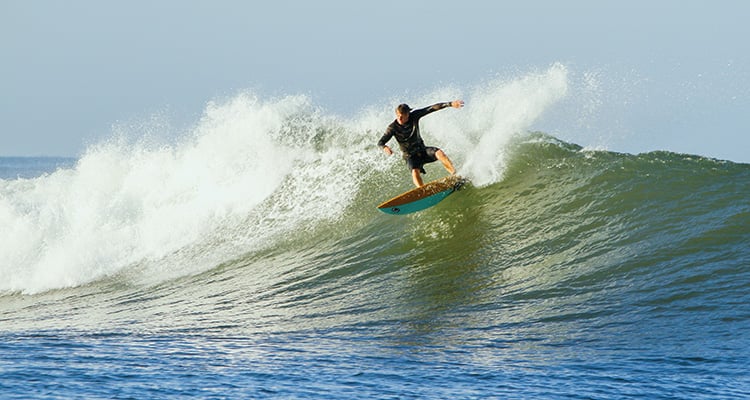
THE SURFBOARD MAKER / Mike Rowe / Southern Shores, N.C.
On the night of Mike Rowe’s high school graduation, the then 18-year-old starry-eyed surfer left his hometown of Virginia Beach and headed south, bound for the Outer Banks. It was a decision that totally altered the course of his life, and one he wouldn’t have changed for anything in the world.
Having been a sponsored surfer in high school, riding for brands like the Australian-based wetsuit company Wavelength, Rowe was committed to the lifestyle. By some amount of dumb luck and serendipity, Rowe crossed paths with Outer Banks surfing icon and surfboard maker Mickey McCarthy. He started sanding boards and learning the trade, never imagining where the journey would lead him.
“I was just a kid living on the Outer Banks,” he says. “It was a piecework job. You didn’t get paid by the hour. You got paid by the piece and if you were good at it, you could make $40 an hour. $40 an hour as an 18-year-old kid during the ‘90s was a fortune.”
For years, Rowe worked making surfboards on the Outer Banks in the summer and on the slopes of Breckenridge in the winter. From snowboards to skateboards and surfboards, Rowe was and still is a boarder through and through. When he finally settled for good on the Outer Banks and built a house, he made sure to put a pool in the back so he could skate, not swim.
In 2001, Rowe split from New Sun Surfboards and set out to make surfboards on his own. He put a shaving room under his house, called it Hooked Surfboards, and set to work. That first year, he cranked out over 80 boards. Having traveled and surfed all over the world, from Hawaii to Indonesia, Rowe had a number of top-level surfing friends who agreed to ride his boards and give him feedback. While Rowe admits he’s “definitely made some dogs in my life as far as boards are concerned,” he felt really fortunate that he not only had the knowledge of what a good surfboard was supposed to look like but also a wealth of experience surfing waves of all types all around the world.
On a trip to Indonesia later that year, Rowe tested a few of his earliest designs. While the number 13 often gets a bad rap as being unlucky if not downright traitorous, it was Rowe’s 13th board—dubbed “Lucky 13”—that gave him the confidence he needed to keep chasing his dream.
“Growth has been totally word of mouth. I have the most rinky dink website, an okay Instagram following, I don’t post on Facebook. I don’t think I’ll ever be a rich person building boards, but that’s only monetarily wise. Every time I think I’m getting down to my last order, I get five more. It’s been a very homegrown thing and I’m fortunate that I live in this small community that supports me.”
This past December, Rowe gave up working carpentry on the side to pursue surfboard making and art full-time. The two go hand in hand—whenever Rowe glasses a surfboard, he shapes the leftover resin into incredible pieces ranging in size from larger-than-life fishbone wall art to ashtrays, “which is the worst use for it, but they come out incredible,” he says.
Rowe has no aspirations of growing his business; he doesn’t want to lose that one-on-one connection with his customers, a relationship that often spans decades as first-timers turn into lifelong surfers and friends. Plus, if he went bigger, when would there be time to surf?
“I know it sounds corny, but our lives are so busy. There’s a lot of chatter and texting and email and all of that just disappears for a few hours out on the water. Golfers probably get that, too, but your phone can still ring on the golf course.”
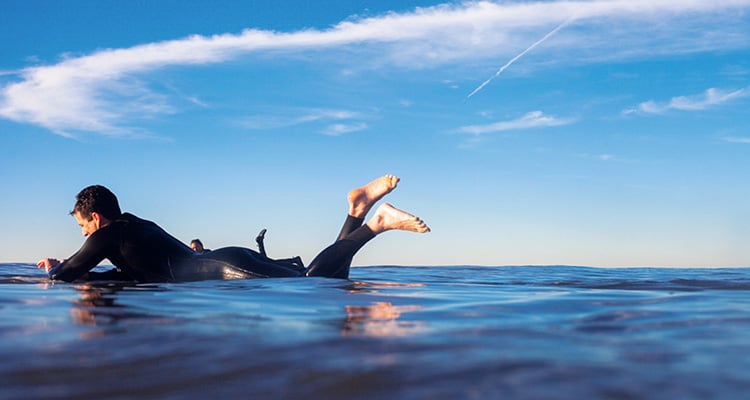
THE WATERKEEPER / Andrew Wunderley / James Island, S.C.
Law school was the last thing on Andrew Wunderley’s mind when he entered graduate school in 2003. A lifelong swimmer and surfer who had found his way to Charleston, S.C., in 1997 to coach the city’s swim team, Wunderley’s primary interest was the environment and the policies behind coastal zone management.
“I remember this pretty distinctly because I went back to school the same year my daughter was born and, long story short, I was looking to get out of grad school as soon as possible. The only course the school was offering in the summer was land use law. Initially I just wanted to get the credits and the grade and move on but I really, really enjoyed it. It was kind of a big surprise.”
By then Wunderley was already in his late 20s with a growing family. Law school, he knew, would require even more of a commitment than graduate school had, both of his time and resources. When the Charleston School of Law opened in 2007, he took it as a sign.
For a few years after law school, he strayed from the environmental and conservation work that had inspired him to go to graduate school in the first place. He worked as a staff attorney for a couple of years and later as a law clerk, but he couldn’t ignore the call of the water for long. Again, destiny intervened. Wunderley knew Charleston Waterkeeper founder Cyrus Buffman, who was just starting the organization at the time. After a few conversations, Wunderley took the leap and came on board as Program Director and Staff Attorney in 2012.
“It was the epitome of a classic startup situation. We barely had an office, we had just put together a Board of Directors, I was using a borrowed desk, all that sort of stuff,” he says, “but I felt like it was something I had to do. I don’t think I would have been happy with myself if I hadn’t taken a chance on it.”
Three years later in 2015, Wunderley took over Buffman’s position as Director and Waterkeeper. He says the work that Charleston Waterkeeper does for the community and surrounding waterways is paramount in this day and age. As of last year, Charleston became South Carolina’s largest city after years of explosive population growth. What that means for Charleston’s rivers and creeks, which together form one of the largest undeveloped estuaries on the East Coast, is immense amounts of stormwater runoff from thoughtless development.
“This place has a wealth of water-based recreation, from fishing to surfing, paddling, sailing. All of that is just steps away from where people live and work. You can surf dawn patrol and still be into work by 9 o’clock. It’s really unique in that regard, but what I worry about is all of those people moving to Charleston every day who don’t have that connection to the rivers and creeks and beaches like we do,” he says. “If you look at everything on the surface, Charleston looks pretty nice and healthy, but we need to help folks build that connection and understand why this place is so special. You protect what you love. That’s the way it works.”
Charleston Waterkeeper offers countless opportunities for volunteers to get involved and help give back to the area’s watershed. Learn more by visiting charlestonwaterkeeper.org/get-involved.
